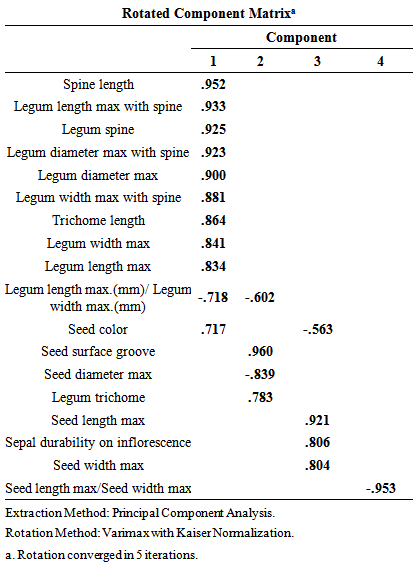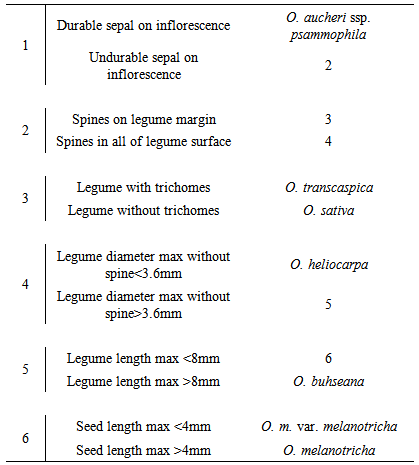-
Paper Information
- Previous Paper
- Paper Submission
-
Journal Information
- About This Journal
- Editorial Board
- Current Issue
- Archive
- Author Guidelines
- Contact Us
International Journal of Modern Botany
p-ISSN: 2166-5206 e-ISSN: 2166-5214
2014; 4(2): 40-47
doi:10.5923/j.ijmb.20140402.02
Numerical Taxonomy of Onobrychis Miller (Hedysareae, Fabaceae) from Markazi Province, Iran Using Pod and Seed Morphological Characters
Mitra Noori1, Mohammad-Mehdi Dehshiri2, Maryam Sharifi2
1Department of Biology, Faculty of Science, Arak University, 38156-8-8349, Arak, Iran
2Department of Biology, Boroujerd Branch, Islamic Azad University, Boroujerd, Iran
Correspondence to: Mitra Noori, Department of Biology, Faculty of Science, Arak University, 38156-8-8349, Arak, Iran.
| Email: |  |
Copyright © 2014 Scientific & Academic Publishing. All Rights Reserved.
Onobrychis Miller (Hedysareae, Fabaceae), with about 150 species in the world and more than 77 species in Iran, in 2 subgenera and 9 sections, includes annual or perennial herbs or shrubs. The genus is mainly distributed in northern temperate regions; however, centres of its genetic diversity are in the Eastern Mediterranean area and South-West Asia. Some pod and seed characters in the genus such as existing and durability of sepal, fruit and seed size, shape, colour, dorsal and ventral ornamentation have important role in seed dispersion and taxonomy. Studies of these characters can revealed the relationship between taxa and used for identification and numerical taxonomy of the species. Twenty three pod and seed quantitative and qualitative characters of nine collected Onobrychis taxa from different part of Markazi Province, Iran were studied using ruler, caliper and a zoom binocular light microscope. Data were coded and analysed by principal component analysis (PCA) test using the SPSS, and then cluster analysis was performed. Results showed morphological studies of pods and seeds of Iranian members of genus Onobrychis showed some characters may support the identification of its species and varieties. Finally a key based on the Onobrychis Miller fruit and seed characters was prepared.
Keywords: Sainfoin, Onobrychis, Hedysareae, Legumes, Pod, Seed
Cite this paper: Mitra Noori, Mohammad-Mehdi Dehshiri, Maryam Sharifi, Numerical Taxonomy of Onobrychis Miller (Hedysareae, Fabaceae) from Markazi Province, Iran Using Pod and Seed Morphological Characters, International Journal of Modern Botany, Vol. 4 No. 2, 2014, pp. 40-47. doi: 10.5923/j.ijmb.20140402.02.
Article Outline
1. Introduction
- The legume is the standard fruit type for Fabaceae family but there is a wide diversity of sub-types present [1]. Some pod and seed characters in some Papilionoideae such as existing and durability of sepal, fruit and seed size, shape, colour, dorsal and ventral ornamentation, wall thickness, pod dehiscing, legume seed number and etc. have important role in seed dispersion and taxonomy. Studies of these characters can revealed the relationship between taxa and used for identification and numerical taxonomy of the legume species [2].Onobrychis L. (sainfoin) is a genus of Papilionoideae subfamily, Hedysareae tribe (Leguminosae) with about 150 species in 2 subgenera and 9 sections, includes annual or perennial herbs or shrubs in the world and more than 77 species in Iran. The genus is mainly distributed in northern temperate regions; however, centres of its genetic diversity are in the eastern Mediterranean area and south-west Asia [3, 4]. Onobrychis sect. Heliobrychis Bunge belongs to the subgenus Sisyrosema Bunge and includes annual or perennial plants, caulescent or acaulescent, with sub-orbicular ecristate and setose fruits. The section comprises 3 subsections [5]. It is predominantly distributed in the Zagros Mountains and north-west Iran. The section with about 24 species is the biggest section in Iran. Its majority species are endemic and important as forage legumes [3, 6, 7, 8, 9]. In sainfoin each pod consists on a single seed that formed indehiscent fruit. There is a positive relation between seed and pod size in sainfoin [10]. Large seed in sainfoin was associated with increased embryo axis length, leaf primordia size, cotyledon area (seed reserve) and rapid seedling growth [11]. The colour of sainfoin fruits has been variously described by Thomson (1951a) [12]. The colour is dark grey to grey green and as papery brown. In good samples the fruits are brown and that very pale yellow or greenish fruits are defective or unripe in good ripe samples the seed pods are fairly bright and the colour is dark straw or a light reddish brown. Very dark and dull looking seeds should be avoided and also pale yellowish-green seeds [12]. Seed characters support the concept of one family as advocated by de Candolle (1825) over 150 years ago [13]. Leguminosae is characterized by seeds with testa composed of usually seven layers (cuticle, epidermis or malpighian layer, hypodermis or sclerid layer, remnant layers, endosperm and cotyledon) [14].In O. viciifolia each flower can produce a kidney-shaped seed contained in a brown pod. Seed production in O. viciifolia assisted by bee pollination should be quite successful [15]. But at best only 55% of the flowers that are pollinated produce seed. This is probably due to the genetic and physiological limitations of the plant [16]. The fruit is either spiny or spineless. The degree of spininess is characteristic for different lines and is genetically determined [17]. The size of the true seeds is variable from 2.5 to 4.5mm long, 2 to 3.5mm broad and 1.5 to 2mm thick. The weight per thousand unmilled seed and milled seed is approximately 24gr and 15gr, respectively. The fruit colour is determined by the ripeness at harvesting time [12, 17]. Here I report the results of a detailed investigation of pod and seed morphology in seven Onobrychis L. taxa (O. aucheri ssp. psammophilla, O. buhseana, O. heliocarpa, O. melanotricha, O. melanotricha var. melanotricha, O. sativa=O. vicifolia and O. transcaspica) from Markazi Province, Iran.
2. Materials and Methods
2.1. Collection of Plant Material and Examination
- Plants of the 7 Onobrychis taxa (O. aucheri ssp. psammophilla, O. buhseana, O. heliocarpa, O. melanotricha, O. melanotricha var. melanotricha, O. sativa=O. vicifolia and O. transcaspica) were collected from different regions of Markazi Provine, Iran. Plants identified using available references and voucher specimens of each species were prepared for reference as herbarium vouchers (Table 1). Voucher samples were deposited at Arak university herbarium. Fourteen quantitative and nine qualitative fruit and seed characters were examined using, ruler, caliper and a zoom binocular (Table 2). Photomicrographs were taken under different magnifications (Figures 1 and 2).
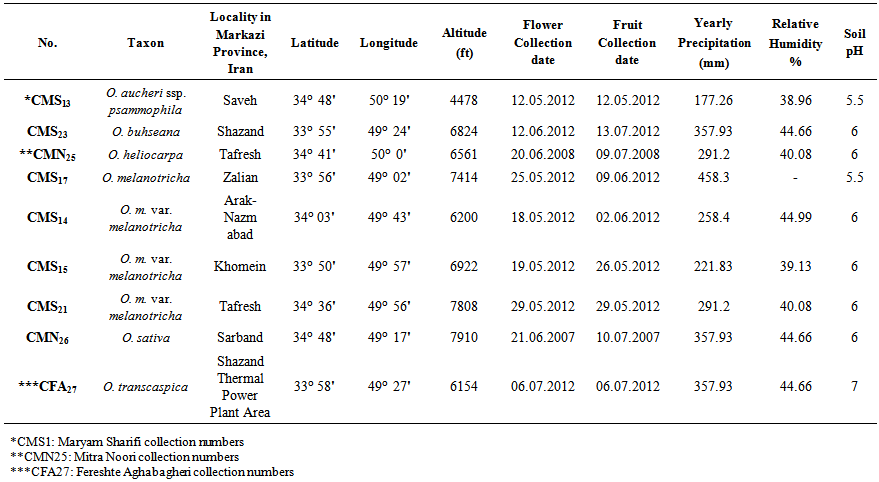 | Table 1. Collection information and climatologically data of studied Onobrychys taxa from Markazi Province, Iran |
 | Table 2. Studied fruit and seed quantitative and scored qualitative characters of Onobrychis species in Markazi Province, Iran |
 | Figure 1. Pods of six studied Onobrychis taxa from Markazi Province, Iran. Numbers are LLM, LWM and LDM respectively in mm (refer to Table 2 for abbreviations) |
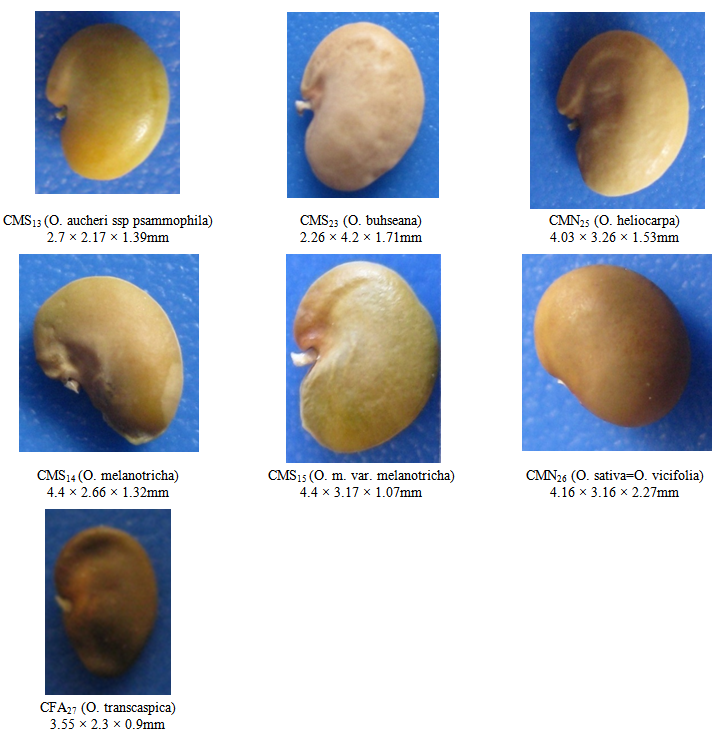 | Figure 2. Seeds of six studied Onobrychis taxa from Markazi Province, Iran. Numbers are SLM, SWM and SDM respectively in mm (refer to Table 2 for abbreviations) |
2.2. Data Analysis
- Principal component analysis (PCA) and hierarchical cluster analysisQualitative characters were coded as multistate characters and the quantitative characters were used. Five characters (legume surface ornamentation, legume trichome, legume seed number, legume dehiscing and seed shape) were deleted in analysis by the reason similarity in all of examined taxa. Data were analyzed using the SPSS (1997) for windows release 16.0 statistical package for social scientists by principal component analysis (PCA) test (Tables 4 and 5) [18]. Then cluster analysis using Ward, Average Linkage (between groups) and Median methods were performed on standardised fruit and seed characters data. Fit of the clusters to the original data was checked using cophenetic correlation (Figure 3). Finally a key based on the Onobrychis Miller fruit and seed characters was prepared (Table 6).
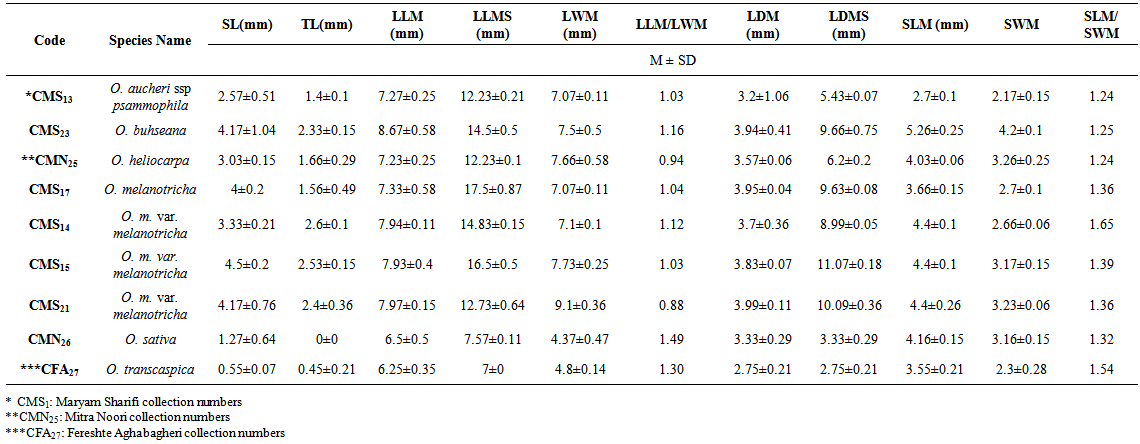 | Table 3. Studied fruit and seed quantitative characters data of Onobrychis taxa in Markazi Province, Iran |
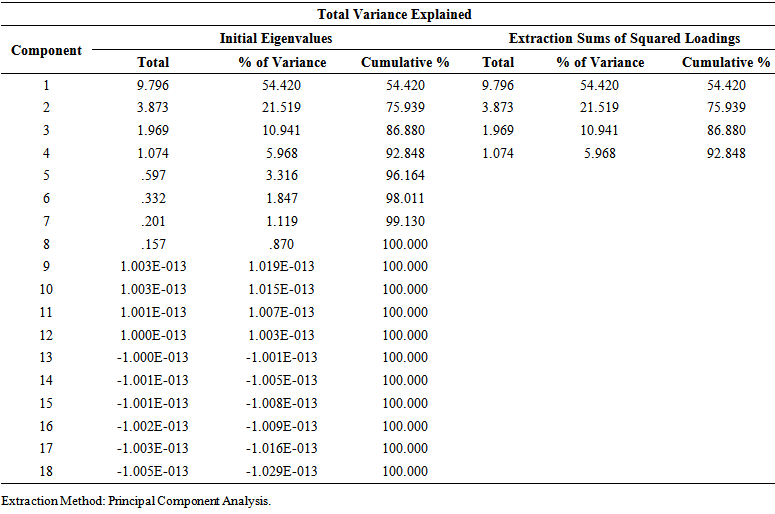 | Table 4. Total variance explained for principal component analysis for fruit and seed characters of studied Onobrychis taxa in Markazi Province, Iran |
|
|
3. Results
- Examined all collected and herbarium specimens are listed in Table 1. Data of studied fruit and seed quantitative characters (M ± SD) of Onobrychis taxa in Markazi Province, Iran have shown in Table 3. As the table shows CMS17 population (O. melanotricha) had the largest pod and CFA27 (O. transcaspica) fruit was the smallest pod. All of studied pods were indehiscent with reticulate and spiny surfaces exceptional of CFA27 and CMN26 that had marginal spine. Legume type was semi circular and legume seed number was one in all of studied populations (Figure 1). All studied taxa seeds were kidney shape and had yellow to brown coulor (Figure 2).Table 4 is shown total variance explained for principal component analysis for studied fruit and seed morphological characters of Onobrychis taxa in Markazi Province, Iran. Table 5 shows four components of PCA test and correlating fruit and seed characters of the studied Onobrychys taxa (P<0.05). Analysing fruit and seed morphological qualitative and quantitative characters using three different cluster analysing method showed the Ward method provided the best data (Figure 3). Table 6 shows an identification key based on the studied Onobrychys characters.
4. Discussion and Conclusions
- Studies on Onobrychys pod and seed morphological characters in Markazi Province, Iran many variations in all of studied characters that pod characters are the most valuable of them for separation of the genus in comparison with other characters. Thomson (1951a & b) and Singh et al. (2009) used these characters for separation and identification of Onobrychys subgenera and sections [10, 12, 17]. Factor analysis results of morpho-biometerical characters in Table 4 and 5 showed that the first four factors describe about 93% of total variance. First components with 54% total variation were found positively correlated with all of studied legume characters with the exception of legume trichome (LTr) and negatively correlated just with legume length max/legume width max (LLM/LWM). Component 2 with 22% total variation was positive and significantly correlated with seed surface groove (SSG) and legume trichome (LTr) and negatively correlated with seed diameter max (SDM). Component three with 11% total variation was correlated positively and significantly with seed length and width max (SLM & SWM) and sepal durability on inflorescence (SDI). Last component 4 with 6% total variation was negatively correlated with seed length max/seed width max (SLM/SWM) character. Figure 3 cluster analysis of morpho-biometerical characters data using cophenetic correlation showed two main clades: first clade consists of two subclades that first one contained five populations of three taxa (O. melanotricha, O. melanotricha var. melanotricha and O. buhseana) and the second sub-clade has two taxa (O. aucheri ssp. psammophilla and O. heliocarpa). Second main clade consists of two species (O. sativa=O. vicifolia and O. transcaspica). As Figure 1 shows all of O. Melanotricha populations are in first sub-clade of the first main clade. Finally study of nine collected Onobrychis taxa from different part of Markazi Province, Iran using morpho-biometerical characters showed legume length, width, diameter max with spine, spine and trichome length, seed surface, colour and width max and sepal durability on inflorescence are positively the most valuable and representative characters for separation of Onobrychis taxa. Legume and seed length max/legume and seed max and seed diameter are negatively the most valuable and representative characters for separation of Onobrychis taxa. These results show that there is a positive relation between seed and pod size in sainfoin as Singh et al. 2009 and Noori et al (2005) found in their studies [2, 10]. Also as Thomson, (1951b) recorded that the degree of spininess is characteristic for different lines and genetically determination (Table 3 and Figures 1) [17]. We know morphology was for a long time the only discipline contributing the characters for systematics and phylogenetic reconstruction [19]. Also morphometrics is used most often to seek patterns of relationship at lower levels in the taxonomic hierarchy, where mosaic patterns make intuitive pattern recognition difficult, if not possible, and in which concepts of holophyly are inappropriate [20]. Therefore study of morpho-biometerical characters are useful in distinguishing among species identification and pod characters are the most valuable of them for separation of the genus in comparison with others (Tables 3 & 5, Figure1). Based on this study results an identification key was prepared (Table 6).
ACKNOWLEDGEMENTS
- The authors would like to thank of Mrs. F. Aghabagheri for collecting and giving in trust sample CFA27 (O. transcaspica).
 Abstract
Abstract Reference
Reference Full-Text PDF
Full-Text PDF Full-text HTML
Full-text HTML
